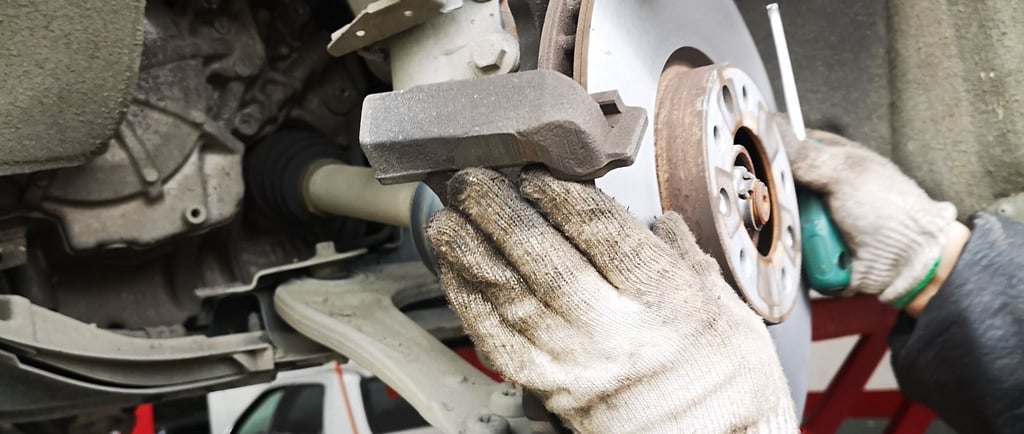Blog Brake Discs: The Unsung Heroes of Your Daily Commute
Brake discs are your daily safety shield—yet often ignored. Learn a 30-second flashlight check, rain-proof habits, OEM vs. aftermarket truths, and a real-life “cheap pads → $ 1,100 bill” caution. Free inspection lists, eco-recycling, and locked online prices at www.xhydronic.com—drive calm, stop safe.
11/10/20252 min read


Every morning, you buckle up, check your mirrors, and pull into traffic. But amid the radio chatter and GPS directions, have you ever listened to the humble brake discs beneath your wheels? They don’t ask for much—just a quick glance now and then—yet they’re the only thing standing between a routine stop and a rear-bumper surprise. Below is a fresh, field-tested playbook that treats you like a smart neighbor, not a sales target. (If you want printable checklists or a quick chat with a tech, hop over to www.xhydronic.com any time.)
1. The 30-Second “Coffee-Shop” Test
While you wait for your latte, crouch beside your front wheel and shine your phone flashlight through the spokes.
Rust rings: A thin orange line is normal; chunky flakes are not.
Groove depth: If you can fit a nickel upright in a groove, the disc is thinning past its comfort zone.
Color bands: Blue-purple streaks mean the metal has overheated—time for a pro look.
Snap a photo each month; you’ll spot changes faster than any “feel” test.
2. The “Wet-Weather Warning” No One Mentions
Rain acts like liquid sandpaper. Waterborne grit embeds in your brake pads and scores the discs in days, not months. Cure: after driving through deep puddles, lightly ride the brakes for 3-4 seconds to dry the surfaces. Cost: $0. Savings: one premature disc replacement ($400+).
3. Brake Disc Ethics: OEM vs. Aftermarket
Myth: “Dealership discs are always better.”
Fact: Many OEM rotors are made by the same foundries as mid-tier aftermarket brands; the difference is the laser-etched part number and the price bump.
Rule of thumb:
Daily commuter? High-carbon aftermarket with anti-rust coating = happy wallet.
Track weekends? Go OEM or premium vented to keep heat fade away.
We publish independent metallurgy reports for every disc we sell—grab them free at www.xhydronic.com.
4. The “Neighborly” Maintenance Calendar
Forget the generic 12-month chart; sync brake care with events you already remember.
Birthday: Check pad thickness (cake + calipers = balanced life).
Daylight-saving time: Inspect disc run-out with a $10 dial gauge borrowed from any parts store.
Vacation road-trip pack: Torque wheels to spec so uneven lug-nut pressure doesn’t warp fresh discs on mile 200.
5. When “Cheap” Costs You a Grand
Real customer story (name changed):
Lisa skipped a $180 pad job; metal backing plates ate into her discs, then cracked a caliper bracket. Final ticket: $1,137.42. Moral: Replace pads at 3 mm—your discs will last two pad lifetimes instead of one.
6. Eco Angle You Can Brag About
Recycling one ton of steel brake discs saves 2,500 lb of iron ore. We collect your old rotors free and send them to a certified smelter. Last year our customers kept 18 tons of metal out of landfills—details at www.xhydronic.com/green.
7. Quick-Fire FAQ (Because We Know You’re Busy)
Q: Can I resurface a disc that’s already below minimum thickness?
A: Legally, no. Shops won’t do it—liability trumps your pleading.
Q: Ceramic pads + standard discs = okay?
A: Perfectly fine; just expect a tiny bit more pedal effort when cold.
Q: Why do my new discs squeak in the morning?
A: Surface flash rust overnight—one medium stop wipes it off. If it lasts all day, pad compound mismatch; call us.
8. Your Next Step (No Sales Trap)
Pick a quiet street, roll to 25 mph, brake firmly. Feel a steering-wheel pulse? Schedule a free run-out check.
Post-inspection, we’ll email you a 360° video of your discs and a straight-talk quote—no “red-urgent” emojis.
Decide on your timeline. Parts price is locked for 30 days online at www.xhydronic.com.
Drive easy, stop confidently, and remember: the best brake job is the one you never have to think about twice.
